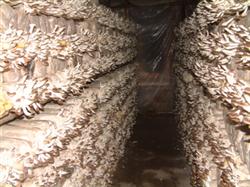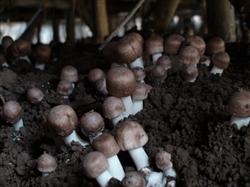Agaricus blazei cultivation technology: how to cultivate Agaricus blazei?

How to cultivate Agaricus blazei Murrill? Please introduce the method of cultivation of Agaricus blazei Murrill with reference to the following methods: 1500 kg-2000 kg of rice wheat straw, 1000 kg-1500 kg of livestock and poultry manure (dry), 75 kg-100kg of rapeseed cake, 35 kg-40 kg of gypsum powder and 30 kg-35 kg of lime. After the raw materials are prepared, the raw materials are fermented. The fermented culture material has a tea-brown color, elastic hands, breaking with a hard pull, and has a special fragrance. Choose a mushroom bed with flat terrain, convenient drainage and a width of 1 m-1.2 m near the water source. And set up a simple 2-meter-high sunshade according to the routine, and hang grass curtains around the bed to prevent the hot sun from shining. Feeding sowing Agaricus blazei Murrill can be sowed twice a year. In spring, sow from the end of March to early April, harvest from May to June; in autumn, sow in the first and middle of August, and harvest from September to November. Before sowing, spray dichlorvos around the pile to kill pests and disinfect the mushroom bed with a little lime powder. The material should be transported to the mushroom bed while it is hot, remove impurities and stack 20 cm thick, and sow seeds when the material temperature drops below 28 ℃. When sowing, break the strain into small pieces, then spread it evenly on the surface of the culture material, gently pat flat and cover with plastic film. 4-6 bags of bacteria are needed per square meter. After sowing, a small arch shed is built to cover the plastic film for heat preservation and moisturizing. From 2 to 4 days after sowing, when the material surface shows white fluffy hyphae, it is necessary to uncover the film and ventilate in time to promote the hyphae to spread to the lower layer of the raw materials. If Mucor, green mold and other miscellaneous bacteria are found to be infected, the contaminated parts should be dug up and destroyed immediately to prevent the spread of infection. With the gradual increase of mycelium growth, the film should be exposed and ventilated 2-3 times a day to keep the air fresh and promote the mycelium to spread and grow. Under normal conditions, 10-15 days after sowing, the hyphae of the material surface are visually white and dense, and have been extended to the lower layer of the raw material by 1 / 3 or 2 / 3, the material surface can be covered with soil. After removing the plastic film on the material surface, cover it with coarse soil first and then with fine soil (all need to be strictly sterilized). The thickness of the covered soil is 3 cm-3.5 cm, of which the coarse soil is 2 cm-2.5 cm, and the fine soil is 1 cm thick. Spray water after covering the soil, and the humidity of the topsoil should be shaped by hand kneading without spreading or sticking to the hand. After 10-15 days of soil covering, when a large number of white cord-shaped hyphae can be seen in the soil, the mushroom can be sprayed quantitatively and the soil water content can be kept at 22%. When a white mushroom bud the size of a grain of rice has been formed in the soil seam, it can be properly ventilated. When the mushroom bud grows to the size of the soybean grain, spray water 2-3 times a day, grasp the principle of spraying more in sunny days, less spraying in cloudy days, and stop spraying in rainy days; do not pour water on young mushrooms so as not to wither and die. During this period, the bed temperature is maintained at 22 ℃-24 ℃, the air relative humidity is between 85% and 90%, and the temperature difference between day and night is too large as far as possible. It is strictly forbidden to be drenched in water around noon during high temperature. When the seed body grows to 2 cm-3 cm, stop spraying water and ventilate regularly to facilitate the healthy growth of the mushroom body. It takes 35-45 days to harvest Agaricus blazei Murrill from sowing to picking mushrooms, and the mushrooms continue to emerge for 2 months-3 months after budding. The fruiting body of Agaricus blazei antler grows rapidly and is easy to open umbrella and change color, so it should be harvested at the right time. Harvest 2-3 times a day during the peak period. Harvest standard: the mushroom cap is hemispherical or oblate, and the bacterial membrane is not broken. When harvesting, gently pull up the middle of the stalk with your hand (do not hurt the young mushrooms around), then scrape away the rotten grass, sediment and other impurities at the base of the stalk with a knife, and put it into a plastic bag for fresh sale. Click to get more planting techniques of Agaricus blazei Murrill
- Prev

Cultivation techniques of Flammulina velutipes: how to manage the fertilizer and water of Flammulina velutipes during mushroom production?
How to manage the fat and water of Flammulina velutipes in the mushroom stage? Please guide because it is not suitable to spray water directly into the fruiting body and material during the mushroom emergence period, the culture material is seriously short of water after 2 tide mushrooms are harvested, so it is difficult to produce mushrooms again. Change the conventional management methods, in Flammulina velutipes mushroom mushroom period timely strengthen fertilizer and water management, can produce mushroom 3-5 tide.
- Next

Planting techniques of Agaricus blazei Murrill: how to grow Agaricus blazei Murrill?
How to grow Agaricus blazei Murrill? Please introduce the method of planting Agaricus blazei Murrill can refer to the following methods: 1, the stacking of culture materials. ⑴ cultivation raw materials. Formula 1: 42% of rice straw, 42% of cottonseed hull, 7% of cow dung, 6% of wheat bran, 1% of phosphate fertilizer, 1% of calcium carbonate, 1% of potassium dihydrogen phosphate, plus 70% of the total water of raw materials. The formula.
Related
- Fuxing push coffee new agricultural production and marketing class: lack of small-scale processing plants
- Jujube rice field leisure farm deep ploughing Yilan for five years to create a space for organic food and play
- Nongyu Farm-A trial of organic papaya for brave women with advanced technology
- Four points for attention in the prevention and control of diseases and insect pests of edible fungi
- How to add nutrient solution to Edible Fungi
- Is there any good way to control edible fungus mites?
- Open Inoculation Technology of Edible Fungi
- Is there any clever way to use fertilizer for edible fungus in winter?
- What agents are used to kill the pathogens of edible fungi in the mushroom shed?
- Rapid drying of Edible Fungi

